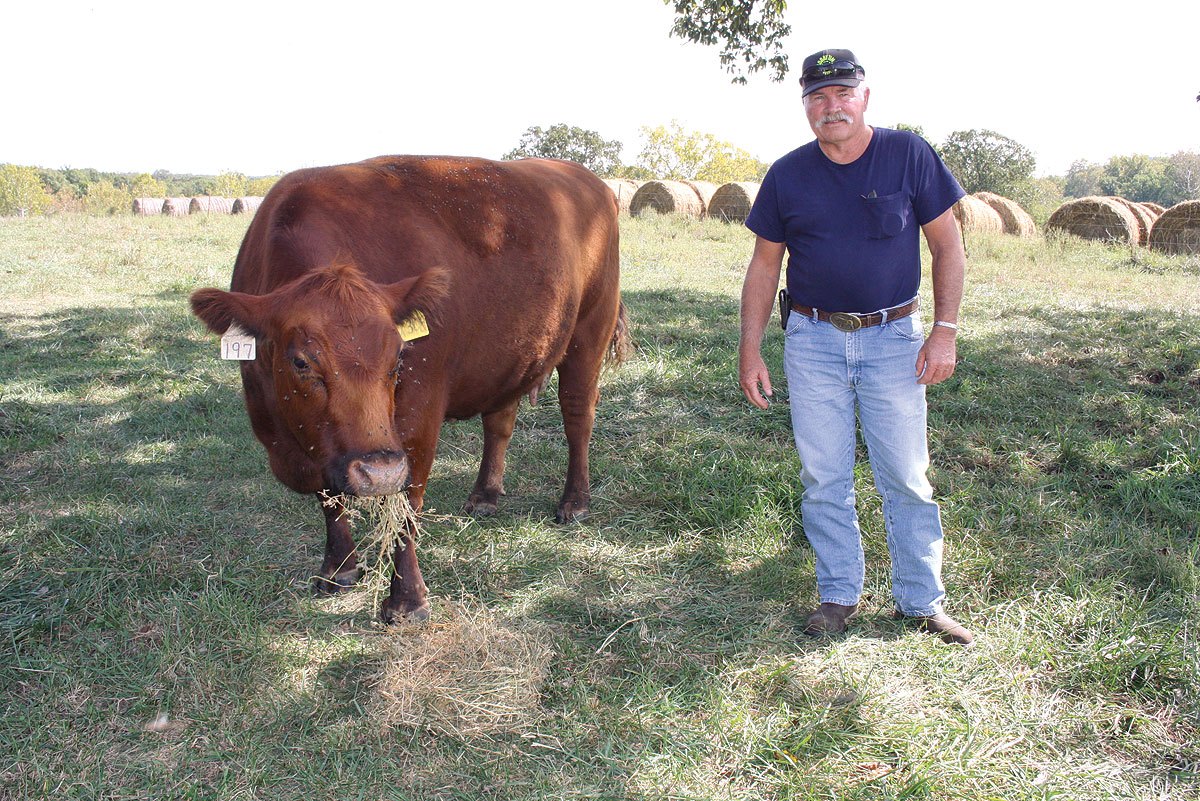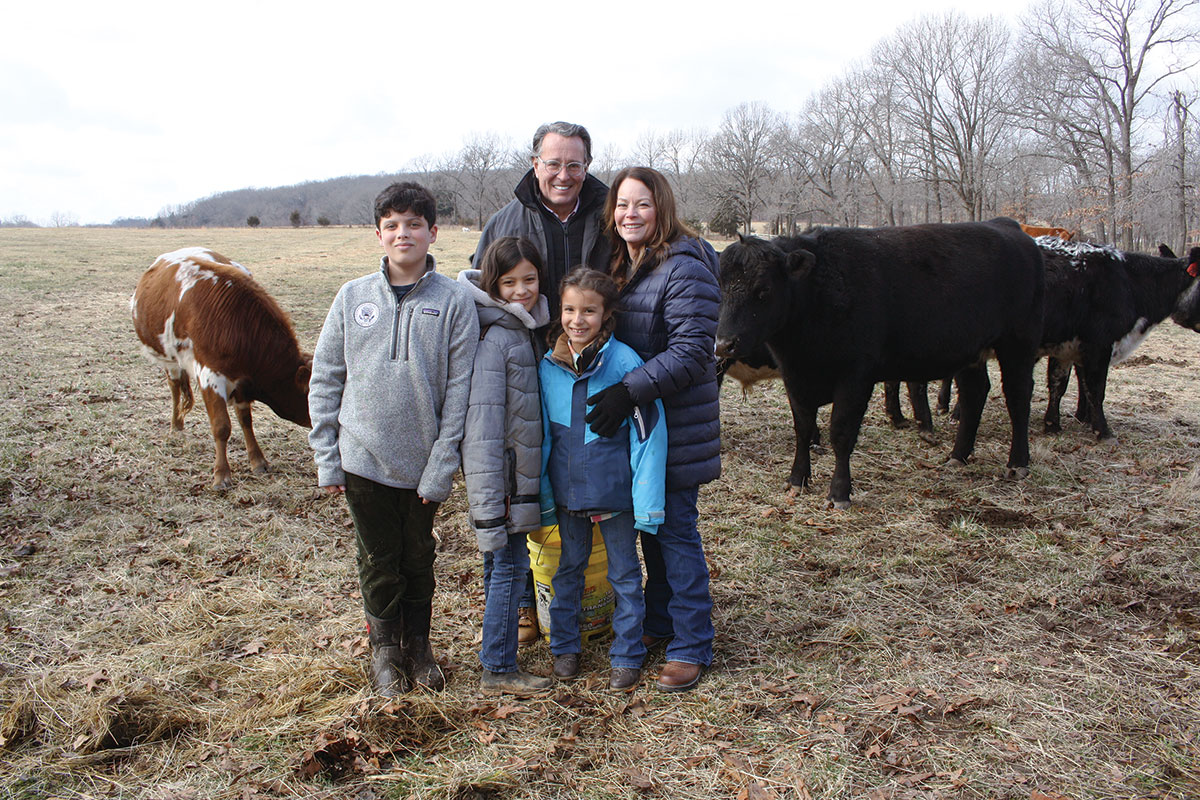
Roy Freeman, Jr., hopes DNA testing will help identify cattle that are tolerant to fescue toxicosis
Roy Freeman, Jr., is very selective about his cattle, and is getting more selective every day. He likes cows that perform well, hold their condition while raising a calf, and calves that grow and gain.
Roy has been in the cattle business for more than 50 years, and is currently raising registered Red Angus, and commercial Red Angus/Gelbvieh cross at his End of the Road Red Angus farm near Collins, Mo.
“We went with the Red Angus bulls because of the calving ease,” Roy said. “I really liked how docile they are. I bought my first bull 10 or 12 years ago and then I bought my first three registered heifers. I really like the carcass traits, too.”
Roy recently introduced Senepols into his commercial herd, which he operates with his son, Roy III. In all, they have about 70 head on rented and owned farms.
“I really like them,” Roy said of the Senepols. “They are a little more hardy in the heat and are really tolerant of the fescue. I’m just getting started with those and I’m really liking them so far.”
According to Oklahoma State University, the Senepol breed was developed on the Caribbean Island of St. Croix and can be traced back to crosses with European taurina (Red Poll) zebu.
When Roy began building his Red Angus herd, he had trouble finding stock tolerant of the tall fescue in the Ozarks.
“I have bought from six or eight different herds, and most of them come from the North or the West and they don’t handle fescue well,” he said. “I’ve gotten heifers from Oklahoma, Kansas, Wisconsin, Montana, from all over just trying to find something that was tolerant to fescue.”
Roy is now DNA testing his registered stock to see which animals have the genetic composition to handle fescue toxicosis. He utilizes a test developed by AgBotanica in Columbia, Mo., that identifies cattle with an improved tolerance to fescue toxicosis. Each animal tested is assigned a “star” rating, based on results of the test, with a 5-star being the best.
“It can really be disappointing,” Roy said with a laugh. “Ones you think might be kind of tolerant really aren’t. I just started testing my bull calves to see where they stood, but I’ve started doing my heifers now. I’ll probably only test my registered cattle because of cost.”
The test is $29 per head, if two or more are tested. The cost goes up to $40 for a single test.
“It’s worth the cost to me on the registered side,” Roy said. “On the commercial side, I can look at a cow and know if she’s doing OK. If not, get rid of her. If she’s got a calf and she’s covered up with hair in July, there’s a chance she’s not doing too good, so I won’t take a chance on her.”
A test result with a anything under three stars is a culling factor for Roy.
“When you have a heifer that you gave a lot of money for her mother, you think she ought to be a pretty good prospect and she isn’t, you want to know why so you don’t do that again,” he explained.
Animals with higher ranks are also culled if they do not have traits Roy finds desirable.
“I had one 5-star bull, but I culled him because I didn’t like his mother; she didn’t breed back, so he was culled immediately,” Roy said, adding he has another 4-star, almost 5-star bull he will be using in his breeding program.
“I wouldn’t take $10,000 for him,” he said of his young bull. “I’m going to put him on a few cows this year because he’s just a little too beefy for heifers. I’m going to test his calves and see if we can make any improvement. I might even breed him back to his half sister to see what we can come up with.”
The breeding program at End of the Road Red Angus is 100 percent natural cover with Red Angus and Senepol bulls, and includes both spring and fall calves.
“People ask me why I don’t AI or do any embryo work and it’s because I haven’t found what I want because no one else is testing for fescue tolerance that I’ve found,” Roy said.
With such a small number of registered animals, about 20, Roy doesn’t really consider himself a seedstock producer, calling the dabbling in genetics, DNA and other factors a hobby, but he wishes he would have began his registered operation years ago.
“I wish I was 25 again,” he retired USDA inspector said. “I could have gotten serious about the seedstock because I like fooling with them and I like the records part of it. It’s a lot of trouble, but I really enjoy it. If I had 500 of them, I probably wouldn’t enjoy it.
“I’d really like to concentrate on developing my herd and being able to advertise that they are 4- and 5-star cattle, and sell stock that way. I think it would be beneficial because there are 40 million acres of fescue in this country and $2 billion in losses because of fungus.”
The testing may be cutting edge for the cattle industry, but how those traits are passed on to offspring is still in the development stage.
“That should be the No. 1 thing we need to look at on EPDs in this part of the country. They talk about weaning weights, yearling weights and everything else, but if they aren’t tolerant of fescue, the rest of that data is mute,” Roy said.
The Senepol cattle, according to research published in the Journal of Animal Science, are more resilient in their capacity for growth under conditions of fescue toxicosis. This trait should help Roy improve his commercial herd’s genetic disposition to tolerate fescue.






